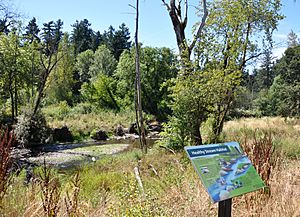Tideman Johnson Natural Area facts for kids
Quick facts for kids Tideman Johnson Natural Area |
|
|---|---|

Creek and woods in the park, 2010
|
|
| Type | Urban park |
| Location | Portland, Oregon, United States |
| Area | 7.69 acres (3.11 ha) |
| Created | 1940 |
| Operated by | Portland Parks & Recreation |
Tideman Johnson Natural Area is a cool city park in southeast Portland, Oregon. It covers about 7.7 acres (3.1 ha) of land. You can find it at Southeast 37th Avenue and Tenino Street. The park is right next to Johnson Creek.
This park is named after a family called Johnson. They lived there in the mid-1800s. The Johnson family wanted people to use their land along the creek. Today, the park has paths for hiking. Some paths are paved, and some are not. There's also a loop trail and a boardwalk. These connect to the Springwater Corridor, which is a popular trail.
Contents
Discover the Wildlife at Tideman Johnson
Tideman Johnson Natural Area is a fantastic spot for watching birds. Many different kinds of birds visit the park. You might see owls, pigeons, kingfishers, and herons.
Birds of the Park
In late spring and early summer, the park's trees are full of birds. You can spot warblers, grosbeaks, and mourning doves. The park has many big-leaf maple trees and alder trees. Other common birds here include sapsuckers and woodpeckers. You might also see chickadees and bushtits.
Fish in Johnson Creek
Johnson Creek flows right through the park. In 2006, a special project helped improve the creek. During this work, experts found 22 different types of fish. They counted 23 Chinook salmon and 107 steelhead trout. This shows that the creek is a healthy home for fish.
Protecting the Park: Maintenance and Restoration
The city of Portland works hard to keep Tideman Johnson Natural Area healthy. The Bureau of Environmental Services (BES) helps with this. They completed a big project in 2006. This project was to fix a sewer line.
Fixing the Sewer Line
The sewer line was built in 1922. It's called the Lents Interceptor sewer. It was buried about 5 feet (1.5 m) under Johnson Creek. Over many years, the creek's water washed away the dirt above the pipe. This left the pipe open and at risk of damage.
During the 2006 project, workers protected the pipe. They surrounded it with concrete. Then, they covered it with rocks. This helps keep the sewer line safe and strong.
Improving the Creek and Habitat
The project also helped the creek itself. Workers reshaped the banks of the stream. They planted 5,300 new trees and shrubs. These plants help prevent the soil from washing away. They also added large boulders and woody debris to the stream. This creates better homes for fish and other wildlife. It also helps stop erosion, which is when soil gets washed away by water.

